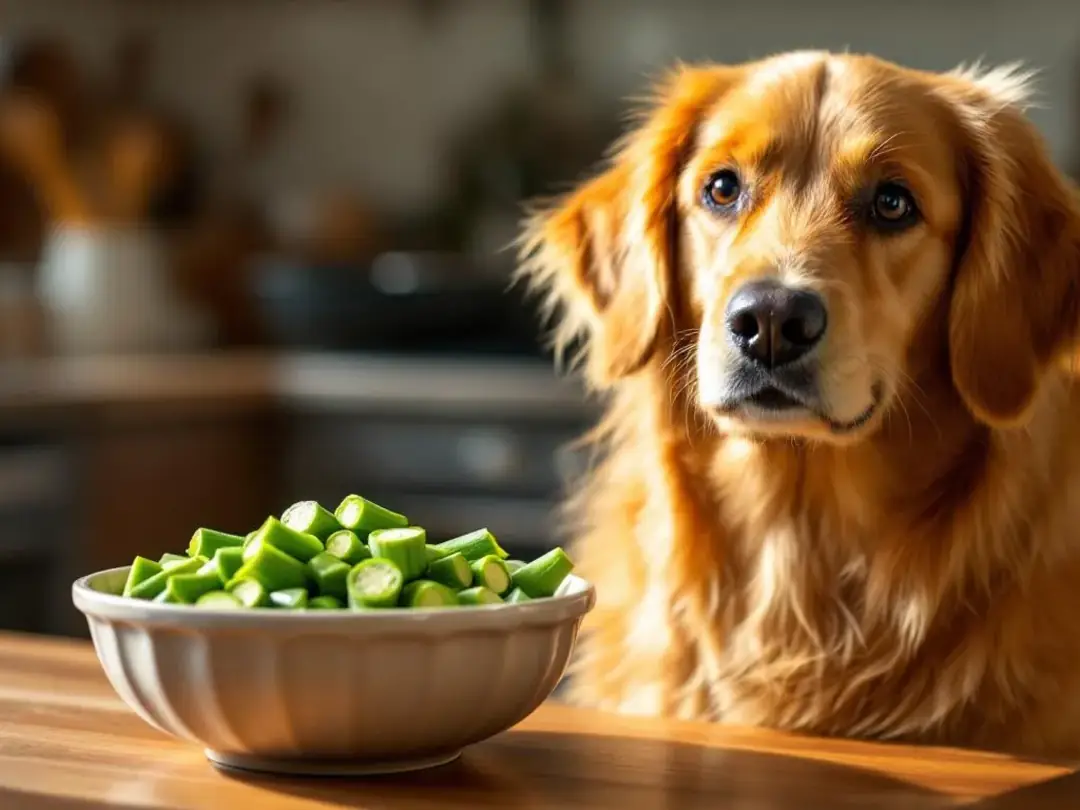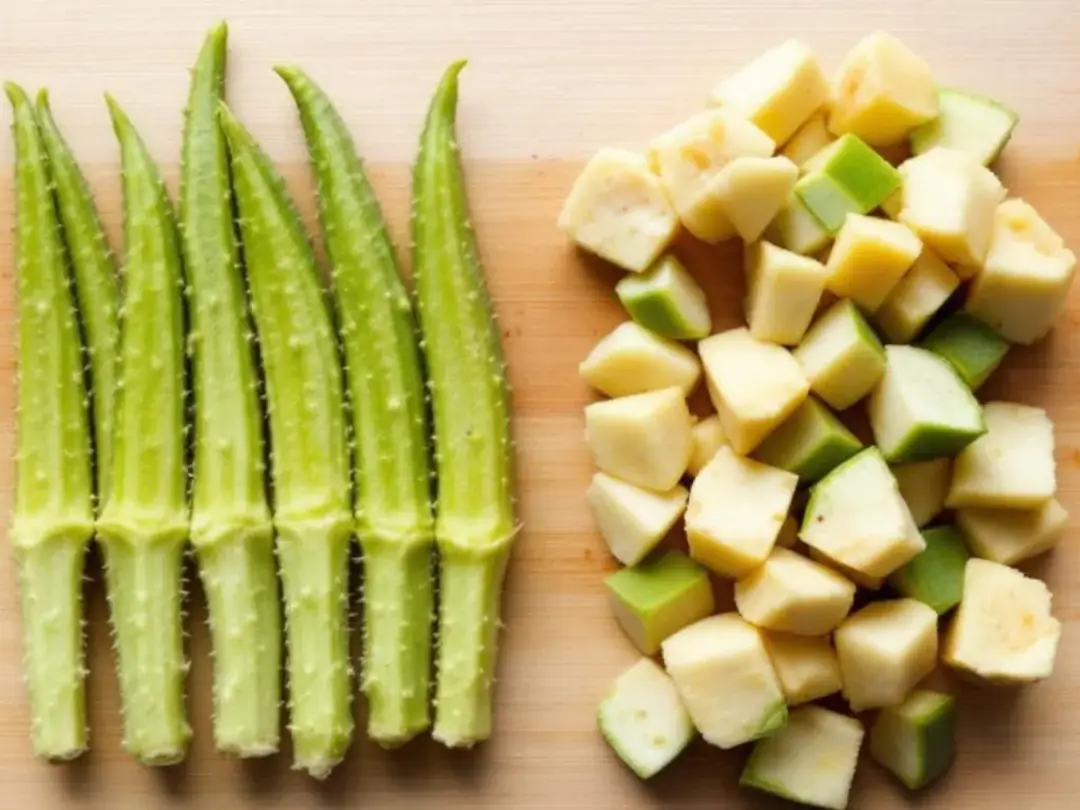Introduction to Okra
Okra, often called lady's finger, is a unique flowering plant that produces edible green seed pods. These pods are not only a staple in many human diets but can also be a healthy snack for dogs when served properly. Rich in vitamins, minerals, and dietary fiber, okra offers various health benefits that can support your dog's immune system and overall well-being. Many pet owners wonder, "Can dogs eat okra?" The answer is yes-dogs can eat okra, and it can be a nutritious addition to their diet when prepared safely. The dietary fiber in okra helps promote healthy digestion, while its abundance of vitamins supports immune health and vitality. So, if you're looking for a new way to boost your dog's nutrition, okra is a great option to consider.
Can Dogs Eat Okra?
Yes, dogs can eat okra safely. This edible green seed pods vegetable is non-toxic to dogs and poses no immediate danger when consumed in appropriate quantities. Both raw okra and cooked okra are acceptable options for dogs, including the okra seeds found inside the pods. Dogs eat okra seeds safely, so there is no need to worry about removing them.
Veterinary experts widely agree that okra is safe for dogs when served properly. While okra isn't yet included in the AAFCO Common Food Index, numerous veterinary-reviewed sources confirm that dogs can eat okra without significant health risks. If your dog accidentally consumes okra, there's typically no need for emergency intervention.
The key to safe okra consumption lies in proper preparation. Plain okra without harmful additives is essential, as seasoned or heavily processed okra can pose serious health risks. Many dogs eat cooked okra, and it is a safe and popular option when prepared by steaming, boiling, or roasting until tender. Dogs eat raw okra as well, and while it is generally safe, some dogs may experience digestive discomfort or allergic reactions due to the texture or other factors. Most dogs can tolerate okra well, making it a potentially healthy addition to their occasional treat rotation.
However, like introducing any new foods to your dog's diet, okra should be offered gradually and in small amounts initially. Overfeeding okra can cause gastrointestinal upset in some dogs, leading to symptoms like gas, bloating, or diarrhea. This approach allows you to monitor how your dog reacts and ensures their digestive system can handle this new vegetable.


Nutritional Benefits of Okra for Dogs
Okra offers various health benefits for dogs through its rich nutritional profile. This vegetable provides essential vitamins, minerals, and beneficial compounds that can support your dog's overall well-being when included as part of a balanced diet. Adding okra to your dog's meals can promote digestive function, weight management, and contribute positively to your dog's health.
Understanding these nutritional benefits helps explain why many pet owners consider okra a healthy snack option for their dogs. When served properly, okra good for dogs due to its low calorie content and high nutrient density, making it particularly appealing for health-conscious pet parents.
Rich in Essential Vitamins and Minerals
Okra is rich in vitamins that support multiple aspects of your dog's health. The high vitamin C content helps strengthen your dog's immune system and aids in wound healing processes. This antioxidant vitamin also supports collagen production, which is crucial for healthy skin and joints.
Vitamin K found in okra plays a vital role in proper blood clotting and supports bone health in dogs. This nutrient is particularly important for active dogs or those recovering from injuries. The vegetable also contains vitamin A, which promotes good eye health and supports vision, especially important for aging dogs.
The mineral content of okra includes potassium, magnesium, and folic acid. Potassium supports proper muscle and nerve function, while magnesium contributes to bone health and energy metabolism. Folic acid is essential for cell division and DNA synthesis, supporting overall cellular health and well being.
Antioxidants present in okra help combat free radicals in your dog's body, potentially reducing inflammation and supporting long-term health. These compounds may contribute to better overall health outcomes, though specific research on dogs remains limited.
High Fiber Content and Digestive Benefits
The dietary fiber in okra provides significant digestive benefits for dogs. This fiber promotes healthy digestion by supporting regular bowel movements and helping prevent constipation. Many dogs, particularly those with sedentary lifestyles, can benefit from the added fiber in their diet.
Fiber also supports the growth of beneficial gut bacteria, which plays a crucial role in immune function and nutrient absorption. A healthy gut microbiome contributes to better overall digestive health and can improve your dog's ability to extract nutrients from their regular food.
For dogs with mild gastrointestinal issues, the gentle fiber in okra may help regulate their digestive system. However, it's important to introduce fiber gradually, as too much fiber can cause digestive upset, including gas and loose stools.
The fiber content also helps dogs feel fuller for longer periods, which can be beneficial for weight management. This satiety effect makes okra a useful tool for dogs that tend to overeat or beg for food constantly.
Low-Calorie, Weight-Friendly Option
With only about 33 calories per 100 grams, okra represents an excellent low-calorie treat option for dogs. This makes it particularly valuable for overweight dogs who need to maintain a caloric deficit while still enjoying occasional treats.
The low calorie content means you can offer okra to your dog without significantly impacting their daily caloric intake. This is especially important since treats should comprise no more than 10% of a dog's daily calories to maintain proper nutritional balance.
Okra's high water content provides additional hydration benefits, which can be particularly valuable during hot weather or for dogs who don't drink enough water throughout the day. This natural hydration support contributes to kidney health and overall well being.
For dogs with diabetes or those prone to weight gain, okra's low glycemic impact makes it a safer treat option compared to many commercial dog treats that are high in sugars and processed carbohydrates.
How to Safely Prepare Okra for Dogs
Proper preparation is crucial when feeding okra to dogs. Just like with most vegetables, the way you prepare okra can significantly impact both its safety and nutritional value for your furry friend. The cooking process and preparation method can significantly impact both the safety and nutritional value of okra for your furry friend. Understanding the best practices for preparing okra ensures your dog receives maximum benefits while minimizing potential risks.
Always start with fresh, high-quality okra when preparing this vegetable for your dog. Wash okra thoroughly under running water to remove any dirt, pesticides, or bacteria that might be present on the surface. This simple step significantly reduces the risk of digestive issues.
Best Cooking Methods
Steaming represents one of the best methods for preparing okra for dogs. This gentle cooking process preserves most of the nutritional benefits while making the vegetable easier to digest. Steam okra for 5-7 minutes until tender, then allow it to cool completely before serving.
Boiled okra is another safe preparation method that softens the vegetable's fibrous texture. Use plain water without salt or other seasonings, and cook until the okra is tender but not mushy. The cooking process makes it easier for dogs to chew and digest.
Light roasting can create a different texture that some dogs find more appealing. Roast plain okra in the oven at a moderate temperature without oils or seasonings. This method reduces moisture content while maintaining nutritional value.
Dogs can eat raw okra safely, though it requires more careful preparation. Raw okra should be washed thoroughly and cut into appropriately sized pieces to prevent choking hazards. Some dogs may find raw okra harder to digest than cooked varieties.
What to Avoid When Preparing Okra
Never add garlic, onions, or other seasonings that are toxic to dogs when preparing okra. These common cooking ingredients can cause serious health problems, including hemolytic anemia and gastrointestinal distress. Even small amounts of these substances can be dangerous for dogs.
Avoid salt, butter, and heavy oils when cooking okra for dogs. These additives can lead to digestive upset, sodium poisoning, or unnecessary caloric intake. Dogs' nutritional needs differ significantly from humans, and these flavor enhancers offer no benefits for canines.
Fried okra should never be given to dogs due to its high calorie and fat content. The breading and oil used in frying can cause digestive issues and contribute to obesity. Additionally, the cooking process often involves harmful additives and excessive sodium.
Pickled okra poses risks due to its high sodium content and acidic vinegar base. The pickling process typically involves salt levels that are dangerous for dogs, and the acidity can cause stomach irritation and digestive upset.
Proper Serving Size and Preparation Tips
Cut okra into bite sized pieces appropriate for your dog's size to prevent choking hazards. Small dogs require smaller pieces, while larger dogs can handle slightly bigger portions. Always err on the side of caution when determining piece size.
Remove tough stems and any fibrous parts that could pose choking risks. The stems are particularly problematic for dogs and should always be discarded before serving. Focus on the tender pod portions that are easier to chew and digest.
Start with just a few pieces to test your dog's tolerance and watch for any adverse reactions. Introduce okra gradually over several days, monitoring for signs of digestive upset or allergic reactions. Most dogs tolerate okra well, but individual sensitivities can occur.
Remember that okra should serve as an occasional treat rather than a dietary staple. Follow the 10% rule, ensuring that treats like okra don't exceed 10% of your dog's daily caloric intake. For most dogs, this means just a few small pieces of okra per serving.
Adding Okra to Your Dog's Diet
When it comes to feeding okra to your dog, moderation is key. While okra can be a nutritious addition to your dog's meals, too much okra at once may lead to digestive upset. It's best to introduce okra gradually, starting with small amounts to see how your dog reacts. Cooked okra is generally easier for dogs to digest than raw okra, making it the preferred choice for most pet owners. Dogs can eat cooked okra as part of their regular meals or as a special treat, but it's important to avoid harmful additives like salt, spices, or oils, which can be unsafe for dogs. By preparing okra simply and serving it in moderation, you can safely add this vegetable to your dog's diet and help them enjoy its nutritional benefits.


Potential Risks and Side Effects
While okra is generally safe for dogs, several potential risks require consideration before adding this vegetable to your dog's diet. Understanding these risks helps you make informed decisions and take appropriate precautions to keep your furry friend safe.
Most adverse reactions to okra in dogs result from improper preparation, excessive consumption, or individual sensitivities rather than inherent toxicity. Being aware of these potential issues allows you to monitor your dog appropriately and respond quickly if problems arise.
Choking and Physical Hazards
The fibrous texture of okra can create choking hazards if pieces are too large or if dogs attempt to swallow them whole. This risk is particularly high for small breeds, elderly dogs with dental issues, or dogs that tend to gulp their food without proper chewing.
Tough stems represent the greatest physical hazard and should always be removed before serving okra to dogs. These fibrous parts are difficult to chew and can become lodged in a dog's throat or digestive tract, potentially requiring veterinary intervention.
Dogs with existing dental problems may struggle to properly chew okra, increasing the risk of choking or digestive blockages. Always supervise your dog when they're eating okra, especially during the first few times you offer this vegetable.
Consider your dog's eating habits when deciding whether okra is appropriate. Dogs that eat quickly or don't chew thoroughly may not be good candidates for okra treats, regardless of proper preparation.
Digestive Issues from Overconsumption
Too much okra can lead to significant digestive upset due to its high fiber content. Symptoms may include gas, bloating, diarrhea, and abdominal discomfort. These issues typically resolve once the excess fiber passes through the system, but they can be uncomfortable for dogs.
The high water content in okra can also contribute to loose stools if dogs consume too much at once. This is particularly problematic for dogs with sensitive stomachs or those not accustomed to high-fiber foods.
Too much fiber can interfere with nutrient absorption from your dog's regular food, potentially leading to nutritional imbalances if okra consumption becomes excessive. This is why moderation is crucial when offering any vegetable treats.
Dogs experiencing persistent digestive issues after eating okra should have this vegetable eliminated from their diet. If symptoms persist beyond 24-48 hours, veterinary consultation may be necessary to rule out other underlying issues.
Allergic Reactions and Individual Sensitivities
Some dogs may develop allergic reactions to okra, though this is relatively uncommon. Symptoms can include itching, skin irritation, hives, swelling, or digestive upset. These reactions typically occur within hours of consumption and may require veterinary attention.
Dogs with existing kidney or bladder issues should avoid okra due to its calcium oxalate content. These compounds can contribute to stone formation in susceptible dogs, potentially exacerbating existing urinary tract problems.
Individual sensitivities can vary significantly between dogs, even within the same breed or household. What's well-tolerated by one dog may cause problems for another, making careful observation essential when introducing okra.
If you notice any concerning symptoms after your dog eats okra, discontinue feeding this vegetable immediately and consult your veterinarian. Document any symptoms you observe to help your vet make appropriate recommendations.
Okra vs Other Dog-Safe Vegetables
Comparing okra to other commonly recommended vegetables helps put its nutritional benefits and risks into perspective. While okra offers unique advantages, many other vegetables provide similar or superior nutritional benefits with potentially fewer risks.
Understanding how okra stacks up against other dog-friendly vegetables can help you make informed decisions about which treats to include in your dog's diet. Variety in vegetable treats ensures a broader range of nutrients and prevents dietary boredom.
How Okra Compares to Popular Dog Vegetables
Carrots provide significantly more vitamin A than okra but contain less fiber and fewer antioxidants. Carrots are also firmer and may pose less of a choking hazard for most dogs, while being easier to digest for sensitive stomachs.
Sweet potatoes offer similar fiber content to okra but are considerably higher in calories and carbohydrates. While sweet potatoes provide excellent nutritional value, they're less suitable for overweight dogs due to their higher caloric density.
Broccoli shares okra's vitamin C content and provides similar antioxidant benefits, but it's more likely to cause gas and digestive upset in sensitive dogs. However, broccoli is more widely available and familiar to most pet owners.
Green beans offer comparable low-calorie benefits with a different texture that many dogs find appealing. They're generally easier to prepare and less likely to cause digestive issues than okra, making them a popular choice for dog treats.
Pumpkin provides similar digestive benefits and fiber content while being more palatable to most dogs. Pumpkin is also less likely to cause choking hazards and is more readily available in dog-friendly prepared forms.
Benefits of Vegetable Variety in Dog Diets
Offering different vegetables ensures your dog receives a diverse range of nutrients that no single vegetable can provide. This variety supports optimal health by covering nutritional gaps that might exist with limited treat options.
Rotating between different vegetables helps prevent your dog from developing food sensitivities or becoming overly dependent on any single treat type. This approach also keeps treat time interesting and engaging for your dog.
Multiple vegetable sources provide insurance against supply issues or seasonal availability problems. Having several safe vegetable options means you can always offer healthy treats regardless of what's available at your local market.
Variety also helps identify any food sensitivities or preferences your dog may have. By observing your dog's reactions to different vegetables, you can create a customized treat rotation that works best for their individual needs.


Simple Okra Recipes for Dogs
These simple recipes provide safe, healthy ways to prepare okra for your furry friend. Remember that these treats should only be offered occasionally and should never replace your dog's regular, nutritionally complete meals.
All recipes emphasize plain preparation without harmful additives. These methods preserve okra's nutritional benefits while ensuring safety for canine consumption.
Basic Steamed Okra Treats
Steam 1 cup of fresh okra pods for 5-7 minutes until tender but not mushy. The okra should be soft enough to cut easily but still maintain some structure. Avoid overcooking, which can make the vegetable too slimy for most dogs.
Cool the steamed okra completely before cutting into small, dog-appropriate pieces. The size should match your dog's ability to chew safely - smaller pieces for small dogs, slightly larger for bigger breeds. Remove any tough stems or fibrous parts during this process.
Serve immediately as occasional treats or mix small amounts with your dog's regular food for added nutrition and variety. You can store leftover prepared okra in the refrigerator for up to 3 days, but always check for freshness before serving.
This basic preparation method preserves most of okra's nutrients while making it easy for dogs to digest. The steaming process also reduces the slimy texture that some dogs find unappealing in raw okra.
Okra and Sweet Potato Mash
Boil equal parts okra and sweet potato until both vegetables are soft and easily mashed. This combination provides complementary nutrients and creates a texture that many dogs find appealing. Cook until both vegetables can be easily pierced with a fork.
Mash the cooked vegetables together without adding any seasonings, oils, or other additives. The natural sweetness of the sweet potato often makes this combination more palatable for dogs who might be hesitant about plain okra.
Cool the mash to room temperature before serving to prevent mouth burns. This recipe can be served as a special treat or mixed into regular dog food in small amounts. The mash consistency makes it particularly suitable for older dogs or those with dental issues.
For convenient storage, freeze the mash in ice cube trays to create individual portion sizes. These frozen treats can be thawed as needed and provide a cooling treat during hot weather.
Dehydrated Okra Chips
Slice okra into thin, uniform rounds approximately 1/4 inch thick. Consistent sizing ensures even dehydration and prevents some pieces from being over or under-dried. Remove any seeds if your dog seems sensitive to them, though they're generally safe.
Arrange the slices on dehydrator trays without overlapping and dehydrate at 135°F for 6-8 hours until crispy. The chips should be completely dry and brittle when finished. Proper dehydration removes moisture that could lead to spoilage.
If you don't have a dehydrator, use your oven at its lowest temperature setting (usually around 170°F) for 2-3 hours. Check frequently to prevent burning and ensure even drying. Some ovens may require leaving the door slightly open to maintain low temperatures.
Store the finished chips in an airtight container at room temperature for up to one week. These crunchy treats provide a different texture that many dogs enjoy and can serve as healthy training rewards.
Roasted Okra Recipe
For a simple and tasty way to serve okra to your dog, try making roasted okra. Start by washing the okra pods thoroughly and cutting them into bite-sized pieces to prevent choking hazards. Spread the pieces evenly on a baking sheet and roast them in the oven at 350°F for 15-20 minutes, or until they're tender. This roasted okra recipe is a healthy, delicious option that many dogs enjoy as an occasional treat. Remember, dogs eat okra best when it's served plain and in small amounts. As with any new foods, always consult your veterinarian before adding roasted okra or other treats to your dog's diet to ensure it's a good fit for their individual needs.
Introducing New Foods: Okra and Your Dog
Introducing new foods like okra to your dog should always be done gradually. Begin by offering a small amount of okra mixed into their regular food and observe how your dog reacts. If your dog tolerates okra well, you can slowly increase the portion over time. However, if you notice any signs of digestive upset or an allergic reaction-such as itching, swelling, or gastrointestinal distress-it's best to stop feeding okra and consult your veterinarian. Dogs can eat okra seeds, which are safe and nutritious, but always ensure the okra is cut into manageable pieces to avoid choking hazards. By taking a careful, step-by-step approach to feeding okra, you can safely introduce this healthy vegetable into your dog's diet and enjoy the benefits it offers.
When to Consult Your Veterinarian
Professional veterinary guidance is essential before adding okra or any new food to your dog's regular diet. Your veterinarian can provide personalized advice based on your dog's specific health status, dietary needs, and medical history.
Certain situations require immediate veterinary consultation rather than waiting for regular check-ups. Understanding when to seek professional advice helps ensure your dog's safety and optimal health outcomes.
Always discuss dietary changes with your veterinarian during regular wellness visits. Even seemingly minor additions like occasional vegetable treats can impact dogs with specific health conditions or dietary restrictions.
If your dog has any chronic health conditions, takes medications, or has a history of food sensitivities, veterinary approval is particularly important before introducing okra. These factors can significantly influence how your dog's body processes new foods.
Contact your veterinarian immediately if your dog shows signs of allergic reaction after eating okra, including difficulty breathing, severe swelling, or persistent vomiting. These symptoms require immediate professional attention and shouldn't be treated at home.
Dogs with a history of kidney stones, bladder issues, or urinary tract problems should not eat okra without specific veterinary approval due to its oxalate content. Your vet can assess whether the potential risks outweigh any benefits for your individual pet.
Persistent digestive issues lasting more than 24-48 hours after feeding okra warrant veterinary consultation. While mild, temporary digestive upset is common when introducing new foods, prolonged symptoms may indicate underlying problems.
When discussing okra with your veterinarian, provide information about your dog's current diet, any other treats or supplements they receive, and your goals for adding vegetables to their routine. This comprehensive information helps your vet make the best recommendations for your pet.
FAQ
Can puppies eat okra?
Yes, puppies over 12 weeks old can eat small amounts of plain, cooked okra, but consult your vet first as their digestive systems are still developing and they need consistent nutrition from puppy-specific food.
Is frozen okra safe for dogs?
Frozen okra is safe when thawed and prepared properly without seasonings, but avoid frozen okra products that contain added salt, butter, or spices which can be harmful to dogs.
How much okra can I give my 50-pound dog?
A 50-pound dog can have 2-3 small pieces of okra as an occasional treat, following the 10% rule where treats shouldn't exceed 10% of their daily caloric intake.
Can okra help with my dog's constipation?
The high fiber content in okra may help with mild constipation, but persistent digestive issues require veterinary evaluation rather than dietary self-treatment.
Should I remove okra seeds before feeding my dog?
No, okra seeds are safe and nutritious for dogs to eat, so there's no need to remove them before serving the vegetable.






